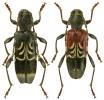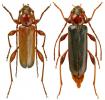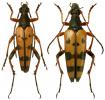Cerambycidae
Common name:
Longhorn beetlesNumber of species:
69Size Range:
2-30mmTarsi:
4-4-4. Lobed.Images:
Description:
The Cerambycidae is one of the largest beetle families worldwide, and has 68 British members. Small to large (2.5-30mm) beetles, they are generally of a characteristic elongate appearance, with broad elytral shoulders tapering backwards and antennae usually at least as long as the body length. Larvae are wood-borers (although Agapanthia villosoviridescens (De Geer) and Phytoecia cylindrica (L.) develop in herbaceous plants), and adults of non-native species are regularly found after emerging from imported timber products, sometimes many years after import.
Adults are often found on flowers (particularly Rutpela maculata (Poda)) or on recently-fallen or felled timber. The house longhorn Hylotrupes bajulus (L.) is a scarce species formerly a pest in houses by developing in structural timbers. Several species (including the largest British species, Prionus coriarius (L.)) can stridulate when disturbed, while others (A. villosoviridescens and the musk beetle Aromia moschata (L.)) can produce characteristic scents.
Five species (Lepturobosca virens (L.), Strangalia attenuata (L.), Cerambyx scopolii Füessly, Obrium cantharinum (L.) and Plagionotus arcuatus (L.)) are thought to be extinct in Britain, and the family as a whole is declining.










